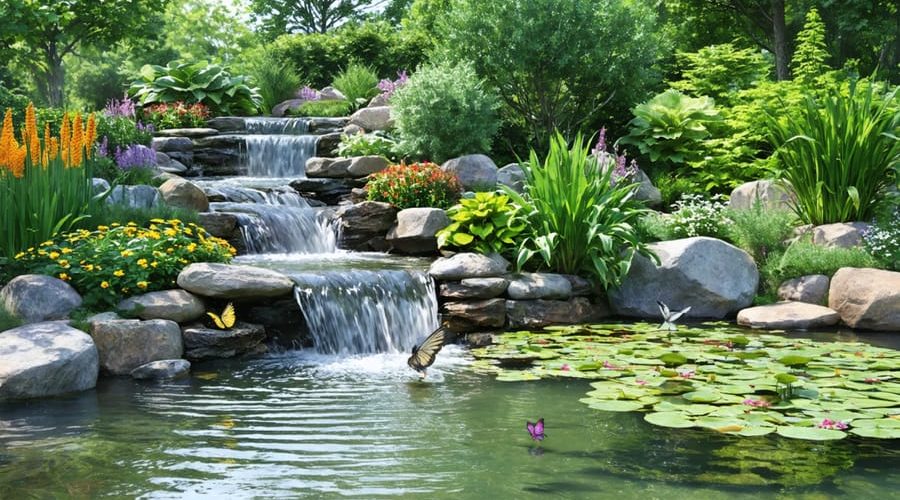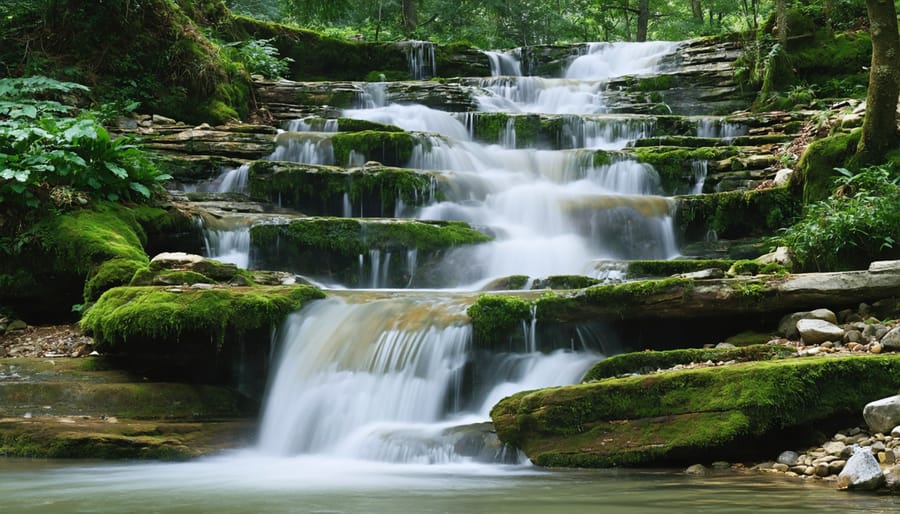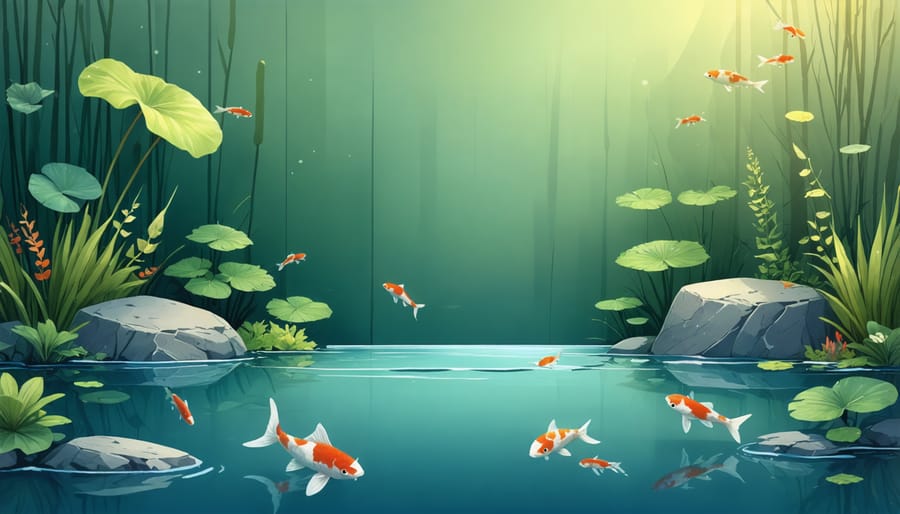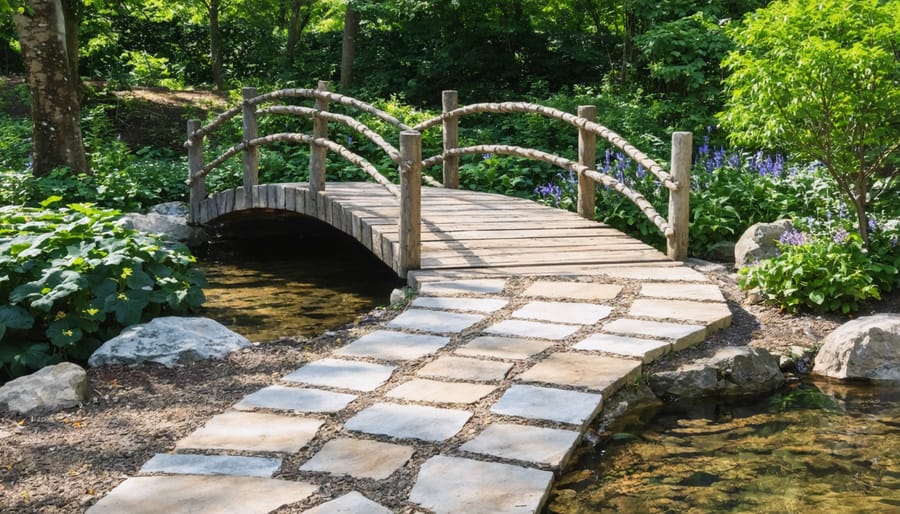
Transform Your Backyard Into a Living Water Garden Paradise
Transform your backyard into a tranquil oasis by designing a water garden that combines flowing fountains, vibrant aquatic plants, and natural stone elements. Water gardens create a dynamic focal point that attracts wildlife, soothes the senses, and adds significant value to your outdoor space. Whether you envision a modest meditation pond or an elaborate ecosystem with multiple waterfalls, the key lies in thoughtful planning and strategic design choices.
Start by selecting the perfect location – one that captures natural light while offering protection from strong winds and falling leaves. Consider incorporating different water depths to support various plant species, from shallow marginal shelves for marsh marigolds to deeper zones for water lilies. Layer your design with essential elements: moving water for ambient sound, strategic lighting for evening ambiance, and carefully selected stones that provide both structure and natural beauty.
Modern water gardens blend seamlessly with eco-friendly practices, incorporating biological filtration systems and native plants that require minimal maintenance. By balancing aesthetics with functionality, your water garden becomes more than just a decorative feature – it’s a living, breathing ecosystem that brings year-round joy and transforms your outdoor space into a peaceful retreat.
Natural Stream and Waterfall Designs
Designing the Perfect Stream Course
Creating a natural-looking stream requires careful planning to achieve that perfect blend of beauty and functionality. Start by mapping out a gently winding path that mimics nature’s organic flow – straight lines rarely occur in natural waterways. Aim for curves that feel purposeful rather than forced, with the stream’s width varying between 2 to 4 feet for a realistic appearance.
When planning depth variations, create a series of shallow rapids and deeper pools. These depth changes not only add visual interest but also create soothing water sounds. Begin with a depth of about 8 inches at the stream’s source, then alternate between shallow sections (4-6 inches) and deeper pools (12-18 inches) along its course.
Natural rockwork is crucial for achieving an authentic look. Place larger boulders at curves to appear as if the water has naturally carved its path around them. Layer smaller rocks and cobbles along the stream’s edges, positioning them at slightly different angles to avoid an artificial appearance. Remember to use local stone types when possible – they’ll look more natural in your landscape.
Don’t forget to include shallow shelves along the edges for marginal plants. These areas, typically 2-4 inches deep, provide perfect spots for water-loving plants that will help soften the stream’s edges and create a seamless transition to your garden landscape. Consider adding small cascades between pools for extra visual and auditory appeal.
Waterfall Construction Techniques
Creating natural-looking waterfalls starts with careful planning and understanding how water flows in nature. When exploring garden pond and waterfall designs, focus on mimicking the irregular patterns found in natural streams.
Begin by stacking larger rocks at the base to create a solid foundation. Layer smaller rocks on top, ensuring each tier has a slight backward slope to direct water flow. A helpful trick is to use foam waterfall underlayment beneath the rocks to prevent water from finding unwanted paths and to create that satisfying sound of flowing water.
For the most natural look, vary the width of water flow at different points. Create some areas where water cascades in a sheet-like manner, while others feature a more controlled trickle. This variation adds visual interest and produces different water sounds throughout your garden.
Remember to incorporate small pools or catch basins between tiers. These not only slow down the water’s descent but also create peaceful resting spots that add depth to your design. Use plants around the edges to soften the look and hide any artificial elements.
For the best sound effects, adjust the height difference between tiers. Generally, drops of 4-6 inches create gentle babbling sounds, while larger drops of 12 inches or more produce more dramatic effects. Test the water flow before finalizing your design, as you can always adjust rock positions to perfect both the look and sound.

Combining Aquatic Plants and Fish
Plant Zones and Ledges
Creating depth zones in your water garden is essential for supporting different types of aquatic plants and creating a natural-looking ecosystem. Think of your pond as having three distinct planting zones: shallow margins, mid-depth shelves, and deep-water areas.
The shallow margins, typically 2-4 inches deep, are perfect for bog plants and marginals like iris and rushes. These areas create a smooth transition from your garden to the water and provide essential cover for small wildlife. Build these ledges at least 12 inches wide to accommodate plant containers comfortably.
Mid-depth shelves, ranging from 6-12 inches deep, support hardy water lilies and other submerged plants. These shelves should be wider, around 18-24 inches, giving plants room to spread. Consider creating multiple mid-depth areas around your pond to achieve a balanced look and provide plenty of planting options.
The deep-water zone, usually 18-30 inches, is crucial for tropical water lilies and provides fish with a safe retreat during extreme weather. Make sure this area is large enough to accommodate the mature size of your chosen plants.
When designing your zones, think about visibility – arrange shorter plants in front and taller varieties toward the back. Create irregular-shaped ledges rather than straight lines to mimic nature. Always ensure your shelves are level to prevent pots from tipping over.
Pro tip: Use stones or rocks to disguise shelf edges and create natural-looking transitions between zones. This not only looks better but also provides additional habitats for beneficial pond life.

Fish-Friendly Features
Creating a fish-friendly water garden goes beyond just adding water and fish – it’s about crafting an environment where your aquatic friends can thrive. Start by incorporating caves and hiding spots using carefully positioned rocks, ceramic pots, or purpose-built fish shelters. These refuges not only protect fish from predators but also provide them with essential resting areas.
Deep zones are crucial for fish health, especially in regions with extreme temperatures. Aim for at least one area that’s 3-4 feet deep, giving fish a cool retreat during summer and a warm haven during winter. This depth also helps maintain stable water temperatures throughout the year, reducing stress on your finned friends.
Don’t forget about shade! Fish need protection from intense sunlight, just like we do. Plant floating aquatic plants like water lilies or lotus to create natural shade patches. Position these plants to cover about 40-60% of your pond’s surface area, ensuring fish have plenty of shaded zones while maintaining good water circulation.
Consider creating different depth levels in your pond using shelves or terraces. This variety mimics natural habitats and provides fish with options to adjust their position based on comfort and temperature preferences. Include gentle slopes rather than steep drops to help fish navigate easily between depth zones.
Remember to add some submerged plants like hornwort or anacharis. These plants not only provide additional hiding spots but also help maintain water quality and offer natural snacking opportunities for your fish. By incorporating these fish-friendly features, you’ll create a more natural, comfortable environment that promotes healthy, happy fish.
Seamless Garden Integration
Transitional Planting
The transition between water and land is a crucial aspect of creating a serene garden atmosphere. Marginal plants and bog gardens serve as natural bridges, softening the edges of your water feature while providing a seamless blend with the surrounding landscape.
Start by selecting moisture-loving plants that thrive in varying water depths. Plants like iris, rushes, and sedges work wonderfully in shallow water areas, while cardinal flowers and marsh marigolds flourish in boggy conditions. Create different planting zones by varying the depth of your pond’s shelves – from completely submerged to slightly damp soil.
A bog garden is particularly effective for this transition. Design it by creating a depression near your pond’s edge, lined with pond liner and filled with organic soil. This area remains consistently moist, perfect for plants that love wet feet but don’t want to be submerged. Consider adding stepping stones through your bog garden to create accessible viewing points and maintenance paths.
Layer your plantings by height, with taller plants like cattails at the back and shorter specimens like creeping Jenny at the front. This not only creates visual interest but also provides hiding spots for wildlife. Remember to include different leaf shapes and textures – broad-leaved plants alongside grassy varieties – to create a rich, natural-looking tapestry that connects your water feature to the rest of your garden.
Hardscape Elements
Hardscape elements form the backbone of your water garden, creating structure and accessibility while enhancing its visual appeal. Start by planning natural-looking pathways that wind around your water feature, using materials like flagstone, gravel, or pavers. These paths not only provide easy access for maintenance but also invite visitors to explore your garden from different angles.
Consider adding a charming wooden bridge over narrow sections of your pond or stream. Even a small footbridge creates a focal point and offers a perfect spot for viewing fish and water plants. For larger water gardens, multiple bridges at strategic points can create different zones and add architectural interest.
Viewing areas are essential for enjoying your water garden to the fullest. Create comfortable seating areas using weather-resistant materials like teak or stone benches. Position these spots where you can best appreciate the sound of flowing water and watch wildlife. Consider building a small deck or patio that extends slightly over the water’s edge, creating an immersive experience.
Don’t forget about lighting along your hardscape elements. Solar-powered path lights or low-voltage LED fixtures can illuminate walkways for safety while creating magical evening ambiance. Strategic uplighting on bridges or near seating areas extends your enjoyment of the water garden into the evening hours.
Remember to integrate these hardscape elements naturally into your landscape by using local materials and maintaining consistent design elements throughout your garden space.

Practical Maintenance Considerations
Easy-Access Features
When designing your water garden, easy access for water feature maintenance should be a top priority. Create dedicated maintenance zones around your pond by leaving at least 2-3 feet of clear space on all sides. This buffer zone makes it much easier to reach filters, clean the edges, and tend to plants without awkward stretching or balancing acts.
Position your pump and filtration equipment in spots that are simple to reach but cleverly concealed. Consider installing them behind decorative rocks or within a fake hollow log that can be easily lifted. For larger ponds, include stepping stones or a small deck that extends slightly over the water, giving you convenient access to deeper areas.
Place electrical outlets at strategic points around your water garden, keeping them safely elevated and protected from moisture. Install conduits underground to hide unsightly cords and protect them from wear. Consider adding outdoor lighting controls in easily accessible locations for convenient evening operation.
If you’re including aquatic plants, arrange them in removable containers or planting baskets positioned near the edges. This makes seasonal maintenance and replanting much simpler. Create shallow shelves or ledges around the perimeter of your pond to safely support these containers and provide stable footing during maintenance tasks.
Remember, the easier it is to maintain your water garden, the more likely you’ll keep up with regular care, ensuring your aquatic paradise stays healthy and beautiful year-round.
Self-Sustaining Systems
Creating a self-sustaining water garden is like building a miniature ecosystem in your backyard. The key is to achieve a natural balance where plants, fish, and beneficial bacteria work together harmoniously. Start by incorporating a variety of aquatic plants – some floating, others submerged – as they naturally filter water and absorb excess nutrients. Water lilies and floating plants provide shade, while oxygenating plants like hornwort help maintain water clarity.
While you’ll want to explore the best filters for water gardens, nature offers excellent filtration solutions too. Consider creating a dedicated bog area where marsh plants act as natural filters. These plants, such as cattails and rushes, excel at removing impurities and providing habitat for beneficial insects.
Adding a few small fish like goldfish can help control mosquito larvae, while snails keep algae in check. Remember to maintain proper plant coverage (about 60-70% of the water surface) to prevent excessive algae growth. A small waterfall or fountain isn’t just beautiful – it adds vital oxygen to the system.
The secret to success is patience. Allow your water garden time to establish its natural cycles. Start with a few hardy plants and gradually add more elements as the system stabilizes. This approach creates a low-maintenance garden that practically takes care of itself while providing year-round beauty and wildlife habitat.
Creating a water garden is an exciting journey that combines artistic vision with natural elements to create your personal oasis. Remember to start with a clear plan, considering factors like size, location, and local climate. Whether you choose a simple container water garden or an elaborate pond system, focus on achieving balance between water features, plants, and hardscaping elements. Don’t be afraid to start small and expand your water garden over time as you gain confidence and experience. The key to success lies in regular maintenance and patience as your ecosystem develops. With these design principles in mind, you’re ready to transform your outdoor space into a tranquil water garden that provides years of enjoyment and creates a stunning focal point in your landscape. Take that first step today and watch as your water garden dreams become reality.
